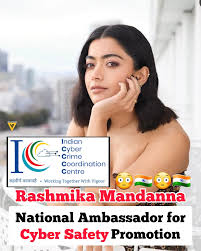As AI reshapes our world, it also brings challenges like deepfakes, which manipulate images and videos to create fake content. Bollywood actress Rashmika Mandanna recently faced this issue when a deepfake video of her emerged. Instead of staying silent, she became a national ambassador for cyber safety, raising awareness and combating digital manipulation.
What Are Deepfakes, and Why Are They Dangerous?
Deepfakes use AI algorithms to create hyper-realistic digital manipulations, making it look like someone is saying or doing something they never did. While deepfakes started as an experimental technology, they have become increasingly accessible, allowing anyone with basic tech skills to create realistic fake content. Unfortunately, this technology is frequently used to produce non-consensual explicit videos, spread misinformation, and launch attacks on public figures and ordinary individuals alike.
When deepfake videos began circulating featuring Rashmika Mandanna, they falsely depicted her in a compromising scenario, leading to public outrage and concerns about privacy. This incident wasn’t just about a celebrity’s image being tarnished—it served as a wake-up call about the darker implications of AI and the urgent need for protective measures.

Rashmika’s Role as a National Ambassador for Cyber Safety:
Following the deepfake controversy, Rashmika Mandanna took on a new role as a national ambassador for cyber safety, determined to use her influence to drive change. Her position aims to:
- 1. Raise Public Awareness: With a massive fan following, Rashmika is in a prime position to educate the public on the risks posed by AI-generated deepfakes. Her personal experience adds weight to her message, making it clear that digital manipulation can affect anyone.
- 2. Empower People to Protect Their Privacy: Cyber safety isn’t just about reacting to threats; it’s about taking proactive measures to avoid them. Rashmika’s advocacy will focus on teaching people how to safeguard their online presence, identify fake content, and report it effectively.
- 3. Push for Stronger Digital Regulations: Alongside raising awareness, her involvement aims to support policy reforms that tackle the misuse of AI technology. By collaborating with government bodies and cyber safety organizations, she can help influence laws that protect individuals from AI-driven exploitation.
Why Rashmika’s Advocacy Matters?
The appointment of Rashmika Mandanna as a cyber safety ambassador is a significant development for several reasons. First, it demonstrates that deepfake threats aren’t just theoretical; they are real, affecting well-known personalities and everyday individuals alike. Her experience offers a compelling case study that highlights the urgent need for action. Here’s why her advocacy is crucial:
- 1. Spotlight on Digital Rights and Privacy: In a time when data privacy is already a hot-button issue, deepfake technology adds another layer of concern. Rashmika’s advocacy places a spotlight on digital rights, encouraging people to be more cautious about their online behavior and take their privacy seriously.
- 2. Combating Misinformation: Deepfakes can do more than harm individual reputations; they can spread misinformation on a massive scale. By raising awareness, Rashmika can help educate the public on how to spot deepfakes and verify the authenticity of online content.
- 3. Inspiring a Broader Movement: Her involvement encourages other celebrities and influencers to join the cause, potentially snowballing into a larger movement advocating for safer digital spaces.
How You Can Protect Yourself from Deepfakes?
Rashmika’s efforts are a reminder that anyone can be a target of digital manipulation. Here’s how you can take practical steps to protect yourself and be more vigilant:
- Limit Your Digital Exposure:
- Strengthen your social media privacy settings: Make your profiles private, and only allow people you trust to see your posts and photos.
- Be selective about the images you share: Avoid posting high-resolution images that can be easily downloaded or manipulated. Consider sharing fewer personal photos online.
- Add Watermarks or Edits to Your Photos:
- Watermark your images: A subtle but visible watermark can discourage potential misuse. While it won’t prevent manipulation entirely, it can make it more challenging for deepfake creators to use your photos convincingly.
- Alter your photos before sharing: Making slight edits to photos—such as adding filters, cropping, or changing the background—can disrupt AI algorithms that rely on consistent visuals for manipulation.
- Regularly Monitor Your Digital Presence:
- Use reverse image search tools: Tools like Google Images and TinEye allow you to search for your photos online, helping you detect unauthorized use.
- Set up alerts for your name and key information: Services like Google Alerts can notify you if your name appears in connection with suspicious content.
- Learn How to Identify Deepfakes:
- Watch for inconsistencies: Deepfakes often exhibit subtle flaws, such as unnatural eye movements, awkward blinking, inconsistent lighting, or audio that doesn’t perfectly match the video.
- Use detection tools: Software like Sensity and Deepware Scanner can help identify deepfake content. These tools analyze videos to determine if they have been manipulated.
- Report Deepfake Content Promptly:
- File a report with the hosting platform: If you come across deepfake content, report it immediately to the social media site or platform hosting the content.
- Consider legal action if necessary: Some jurisdictions have laws against non-consensual image manipulation. If the content is severely harmful, consult with a lawyer about your options.
Rashmika’s Advocacy: What Comes Next?
As Rashmika Mandanna steps into her new role, her focus will likely include public campaigns to educate people about cyber threats, workshops on digital safety, and working with authorities to ensure laws evolve with technological advancements. She aims to make cyber safety a household topic, encouraging everyday internet users to take small but effective measures to protect themselves.
Her decision to turn a distressing situation into a catalyst for positive change is a bold move, inspiring others to speak out against digital manipulation and work towards a safer online environment. Rashmika’s role could be a game-changer, opening the door for more influential figures to step up and advocate for online safety.
Conclusion:
Rashmika Mandanna’s journey from being a victim of deepfake manipulation to becoming a national ambassador for cyber safety is a powerful example of resilience and leadership. Her advocacy aims to protect not just herself but also millions of others from falling victim to digital exploitation.
In a world where the lines between reality and manipulation are increasingly blurred, her message is clear: we must all play a part in protecting our digital spaces. By staying informed, taking proactive steps, and supporting calls for stronger regulations, we can help create a safer and more secure online world for everyone.

Pooja is an enthusiastic writer who loves to dive into topics related to culture, wellness, and lifestyle. With a creative spirit and a knack for storytelling, she brings fresh insights and thoughtful perspectives to her writing. Pooja is always eager to explore new ideas and share them with her readers.